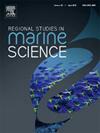A prospective study on the biodegradation of petroleum hydrocarbons mediated by selected marine bacterial isolates
IF 2.1
4区 环境科学与生态学
Q3 ECOLOGY
引用次数: 0
Abstract
Petroleum hydrocarbons are an indispensable energy source and serve as a fundamental feedstock for petroleum oil refiners and petrochemical industries. The release of petroleum hydrocarbon pollutants into the environment is associated with anthropogenic activities during crude oil production, exploration, and transportation. The widespread petroleum hydrocarbons pollutants in the environment caused a major concern due to their bioaccumulation potential and harmful effect on the ecosystem. Nevertheless, such polluted environment with petroleum hydrocarbons is enriched with microorganisms that have the natural ability to utilize the petroleum hydrocarbons as a carbon source for their growth and metabolic activities. Therefore, this study focused on the isolation, molecular identification and characterization of bacterial isolates from seawater samples collected at the coastal area nearby oil Refinery Company in Oman. Six marine bacteria were isolated from the contaminated seawater and their taxonomical identification was performed based on 16S rRNA gene sequence. The degradation potential of bacterial isolates was assessed by growing them in F/2 medium supplemented with crude oil as a sole carbon source. Two bacterial isolates belonging to the genus Niallia showed the strongest growth (S1.5: 1.01 ± 0.27 and S2.1: 0.88 ± 0.23) and were subjected to further Gas Chromatography–Mass Spectrometry (GC-MS) analysis determining which n-alkanes in crude oil were degraded by the isolates. The GC-MS chromatogram indicated that S2.1 exhibited greater efficiency in degrading a higher number of carbon n-alkanes (C13-C34) com-pared to S1.5 (C13-C18). The t-test analysis confirmed the efficiency of S2.1 (t = 3.182; p < 0.01) (93.61 ± 1.48 %) compared to S1.5 (86.08 ± 1.85 %). Molecular docking revealed robust binding affinities between selected n-alkanes and alkane hydroxylases, facilitating the subsequent degradation of n-alkanes in crude oil. The degradation potential of Niallia can be further exploited for the treatment of petroleum contaminated, especially with the incorporation of recent technological advancements.
求助全文
约1分钟内获得全文
求助全文
来源期刊

Regional Studies in Marine Science
Agricultural and Biological Sciences-Ecology, Evolution, Behavior and Systematics
CiteScore
3.90
自引率
4.80%
发文量
336
审稿时长
69 days
期刊介绍:
REGIONAL STUDIES IN MARINE SCIENCE will publish scientifically sound papers on regional aspects of maritime and marine resources in estuaries, coastal zones, continental shelf, the seas and oceans.
 求助内容:
求助内容: 应助结果提醒方式:
应助结果提醒方式:


